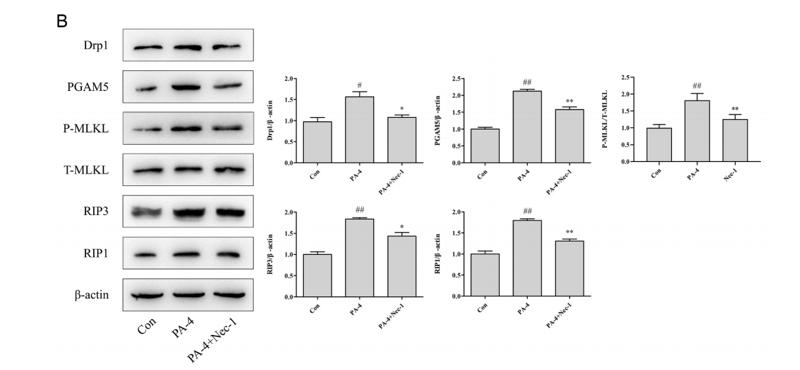PGAM5 Antibody - #DF13355
| Product: | PGAM5 Antibody |
| Catalog: | DF13355 |
| Description: | Rabbit polyclonal antibody to PGAM5 |
| Application: | WB IHC |
| Reactivity: | Human, Mouse, Rat |
| Prediction: | Bovine, Horse, Sheep, Rabbit, Dog, Chicken |
| Mol.Wt.: | 32KD; 32kD(Calculated). |
| Uniprot: | Q96HS1 |
| RRID: | AB_2846374 |
Related Downloads
Protocols
Product Info
*The optimal dilutions should be determined by the end user.
*Tips:
WB: For western blot detection of denatured protein samples. IHC: For immunohistochemical detection of paraffin sections (IHC-p) or frozen sections (IHC-f) of tissue samples. IF/ICC: For immunofluorescence detection of cell samples. ELISA(peptide): For ELISA detection of antigenic peptide.
Cite Format: Affinity Biosciences Cat# DF13355, RRID:AB_2846374.
Fold/Unfold
Bcl-XL-binding protein v68; BXLBv68; MGC5352; mitochondrial; PGAM5; PGAM5_HUMAN; Phosphoglycerate mutase family member 5; Serine/threonine protein phosphatase PGAM5 mitochondrial; Serine/threonine-protein phosphatase PGAM5;
Immunogens
- Q96HS1 PGAM5_HUMAN:
- Protein BLAST With
- NCBI/
- ExPASy/
- Uniprot
MAFRQALQLAACGLAGGSAAVLFSAVAVGKPRAGGDAEPRPAEPPAWAGGARPGPGVWDPNWDRREPLSLINVRKRNVESGEEELASKLDHYKAKATRHIFLIRHSQYHVDGSLEKDRTLTPLGREQAELTGLRLASLGLKFNKIVHSSMTRAIETTDIISRHLPGVCKVSTDLLREGAPIEPDPPVSHWKPEAVQYYEDGARIEAAFRNYIHRADARQEEDSYEIFICHANVIRYIVCRALQFPPEGWLRLSLNNGSITHLVIRPNGRVALRTLGDTGFMPPDKITRS
Predictions
Score>80(red) has high confidence and is suggested to be used for WB detection. *The prediction model is mainly based on the alignment of immunogen sequences, the results are for reference only, not as the basis of quality assurance.
High(score>80) Medium(80>score>50) Low(score<50) No confidence
PTMs - Q96HS1 As Substrate
| Site | PTM Type | Enzyme | Source |
|---|---|---|---|
| K75 | Acetylation | Uniprot | |
| K75 | Ubiquitination | Uniprot | |
| S80 | Phosphorylation | Uniprot | |
| S87 | Phosphorylation | Uniprot | |
| K88 | Acetylation | Uniprot | |
| K88 | Ubiquitination | Uniprot | |
| K93 | Acetylation | Uniprot | |
| K93 | Ubiquitination | Uniprot | |
| Y108 | Phosphorylation | Uniprot | |
| K116 | Acetylation | Uniprot | |
| T131 | Phosphorylation | Uniprot | |
| K141 | Acetylation | Uniprot | |
| K141 | Ubiquitination | Uniprot | |
| K144 | Acetylation | Uniprot | |
| K144 | Ubiquitination | Uniprot | |
| C168 | S-Nitrosylation | Uniprot | |
| K169 | Ubiquitination | Uniprot | |
| S171 | Phosphorylation | Uniprot | |
| K191 | Acetylation | Uniprot | |
| K191 | Ubiquitination | Uniprot | |
| S253 | Phosphorylation | Uniprot | |
| K285 | Ubiquitination | Uniprot |
Research Backgrounds
Displays phosphatase activity for serine/threonine residues, and, dephosphorylates and activates MAP3K5 kinase. Has apparently no phosphoglycerate mutase activity. May be regulator of mitochondrial dynamics. Substrate for a KEAP1-dependent ubiquitin ligase complex. Contributes to the repression of NFE2L2-dependent gene expression. Acts as a central mediator for programmed necrosis induced by TNF, by reactive oxygen species and by calcium ionophore.
Both isoform 1 and isoform 2 are phosphorylated by the RIPK1/RIPK3 complex under necrotic conditions. This phosphorylation increases PGAM5 phosphatase activity.
Mitochondrion outer membrane>Single-pass membrane protein.
Note: Isoform 2 overexpression results in the formation of disconnected punctuate mitochondria distributed throughout the cytoplasm. Isoform 1 overexpression results in the clustering of mitochondria around the nucleus.
Dimer. Forms a ternary complex with NFE2L2 and KEAP1. Interacts with BCL2L1 and MAP3K5. Upon TNF-induced necrosis, forms in complex with RIPK1, RIPK3 and MLKL; the formation of this complex leads to PGAM5 phosphorylation. Isoform 2, but not isoform 1, interacts with DNM1L; this interaction leads to DNM1L dephosphorylation and activation and eventually to mitochondria fragmentation.
The N-terminal 35 amino acids, including the potential transmembrane alpha-helix, function as a non-cleaved mitochondrial targeting sequence that targets the protein to the cytosolic side of the outer mitochondrial membrane.
Belongs to the phosphoglycerate mutase family. BPG-dependent PGAM subfamily.
Research Fields
· Cellular Processes > Cell growth and death > Necroptosis. (View pathway)
· Environmental Information Processing > Signal transduction > TNF signaling pathway. (View pathway)
References
Application: WB Species: Human Sample: L-02 cells
Restrictive clause
Affinity Biosciences tests all products strictly. Citations are provided as a resource for additional applications that have not been validated by Affinity Biosciences. Please choose the appropriate format for each application and consult Materials and Methods sections for additional details about the use of any product in these publications.
For Research Use Only.
Not for use in diagnostic or therapeutic procedures. Not for resale. Not for distribution without written consent. Affinity Biosciences will not be held responsible for patent infringement or other violations that may occur with the use of our products. Affinity Biosciences, Affinity Biosciences Logo and all other trademarks are the property of Affinity Biosciences LTD.

